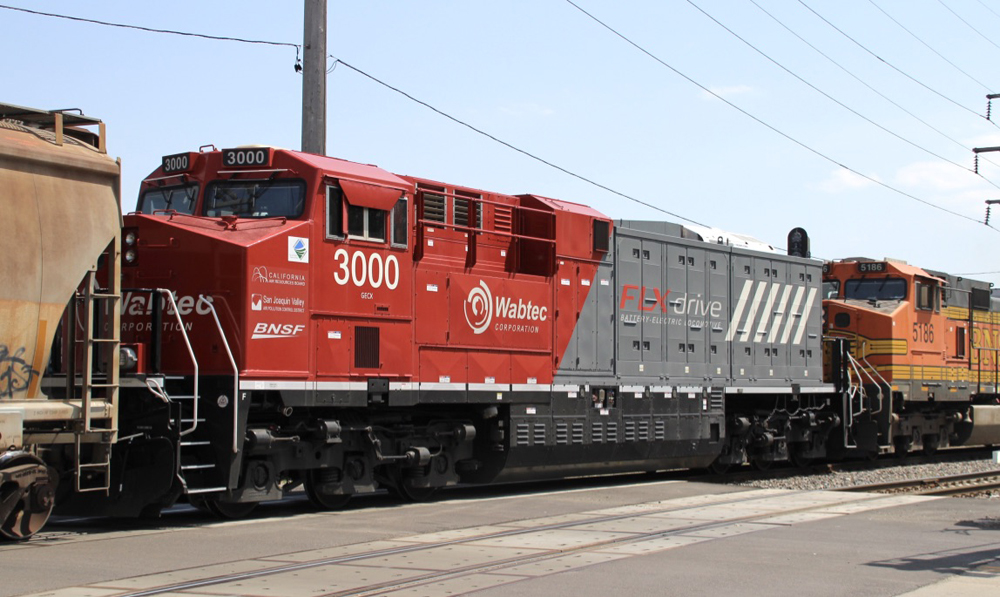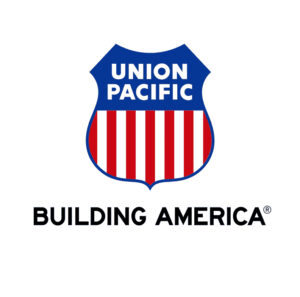

OMAHA, Neb. — Union Pacific will purchase 20 battery-electric locomotives to test in yard service, the largest commitment to date for the technology by any rail operator.
In separate announcements Friday, the railroad announced purchase of 10 Wabtec FLXdrive locomotives and 10 of Progress Rail’s EMD Joule locomotives. The railroad said the cost of the locomotives and related upgrades to yard infrastructure will exceed $100 million.
“We’re committed to actions that reduce Union Pacific’s environmental footprint as we work toward our ultimate goal of reaching net zero emissions by 2050,” Union Pacific CEO Lance Fritz said in a press release. “These investments will contribute to further developing this important technology and providing industry-wide benefits.”
Fritz had indicated that the railroad was prepared to test the technology in yard service in a conversation this month with Trains News Wire, saying the railroad would deploy locomotives at one warm-weather and one cold-weather site [see “UP nearing purchase of battery-electrics …,” Trains News Wire, Jan. 6, 2022]. The locomotives purchased on Friday will be used at North Platte, Neb., and in the Los Angeles Basin.
“We think you can get an eight-hour shift out of a properly designed [battery-electric],” Fritz said on Jan. 6. Yard usage, he said then, is the “best-case use for current battery-electric locomotive technology.”
The FLXdrive yard locomotives will have a power capacity of approximately 2.5 megawatt-hours, roughly the same as the demonstrator tested last year by BNSF Railway in road service in California. Most recent FLXdrive orders have been for a 7-megawatt road locomotive.
Union Pacific’s release did not offer specifics on the Progress Rail locomotives, but a subsequent press release from Progress parent Caterpillar said the locomotives would be built at the Progress plant in Muncie, Ind., with the first units delivered in late 2023 and the order completed by 2024.
“We are pleased to supply our EMD Joule locomotives to Union Pacific, representing our largest battery-electric locomotive order to date,” Caterpillar Chairman and CEO Jim Umpleby said. “At Caterpillar, we’re continuing to invest in new products, technologies and services to support our customers during the energy transition, helping them achieve their climate-related goals as they build a better, more sustainable world.”
Progress has announced plans to test a 2.4-megawatt-hour unit on Southern California’s Pacific Harbor Line [see “Pacific Harbor Line to test new Progress Rail battery locomotive,” News Wire, Nov. 13, 2020]. It has also sold 14.5 megawatt-hour road locomotives to Australian customers; those locomotives are slated to be built in Brazil.
“Railroads are already the leader in low emissions ground transportation, and we believe battery-electric locomotives are the next step in our journey to eventually reach net zero,” Fritz said in Friday’s release. “This first phase of testing will further enhance the technology, and, ultimately, benefit the entire industry.”
Wabtec CEO Rafael Santana said UP “is pioneering a major application of battery power in its rail yards. … Battery power is an ideal solution to reduce the environmental impact and costs of yard operations. Using the FLXdrive in the rail yard can significantly improve local air quality, as well as reduce noise by up to 70% for neighboring communities.”
UP estimates each group of 10 locomotives will eliminate 4,000 tons of carbon annually, the equivalent of removing 800 cars from the highway. The railroad says that it hopes work with manufacturers in this program will help advance battery-electric development and lead to potential use in long-haul service.
The Port of Los Angeles is awarding UP funds to partially cover the costs of one of the locomotives, out of funding it received from a U.S. Environmental Protection Agency Diesel Emission Reduction Act grant.
— Updated and revised at 1:30 p.m. CST with announcement of purchase of 10 Progress Rail locomotives; updated at 8:25 p.m. on Jan. 29 with additional details and comment on Progress Rail portion of order.














“UP estimates each group of 10 locomotives will eliminate 4,000 tons of carbon annually, the equivalent of removing 800 cars from the highway.”
Ask Wabtec and Progressive Rail how many tons of carbon were added to get these things built. Especially those batteries.
So they hope to get an eight hour shift out of it. How long before it is recharged before they can reuse it?
Crew might be tempted to use more power than necessary to get an early quit.
2.5 megawatt hours is roughly 3350 HP hours. This is 3350 HP for 1 hour, 1675 HP for 2 hours, 838 hp for 4 hours, or 419 HP for 8 hours. This doesn’t sound like enough, but this is an average. Most switchers aren’t running at full throttle most of the time. Regenerative braking can also charge the batteries, adding to battery life.
The 14.5 MW hour road locos are nearly 20,000 HP hours. That would be 2000 HP for 10 hours, but again, they are not running full throttle the entire time and may also do some regenerative braking. Battery powered road locos can also be consisted with diesels so that regenerative braking from ALL units can charge the battery-powered one, keeping it charged, but reducing fuel consumption compared to an all diesel consist.
I certainly hope the larger number of 10 will enable to evaluate the feasibility of buying more. So, if 1 or 2 fail and rest meet specs then UP will maybe have a new way to lower emissions somewhat.
UP will have to take in account of energy production into account.
If test fails, then the RRs will need to go back to drawing board. Maybe electrification with CAT? Who knows for sure?
The manufacturers and railroads do NOT take into account the energy required to produce anything they buy when it comes to determining carbon emissions…at least not on a realistic level, most industry doesn’t.
We had a green monster at the UP Auto Facility in Mira Loma,CA.
It failed to cut the mustard.
Then, we had a variable power switcher. It always needed maximum power to move the cars. Between breakdowns one day, one of them caught fire.
But that was California where the CARB frets over lawn mower emissions.